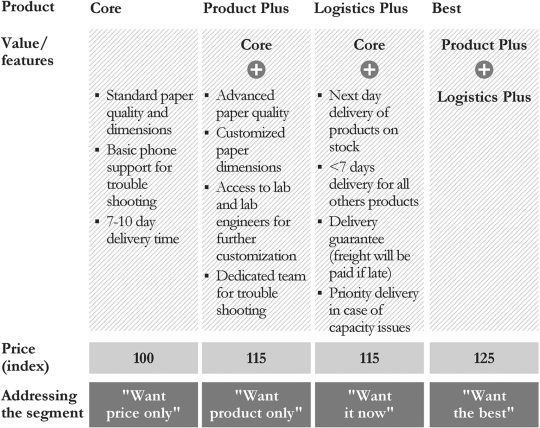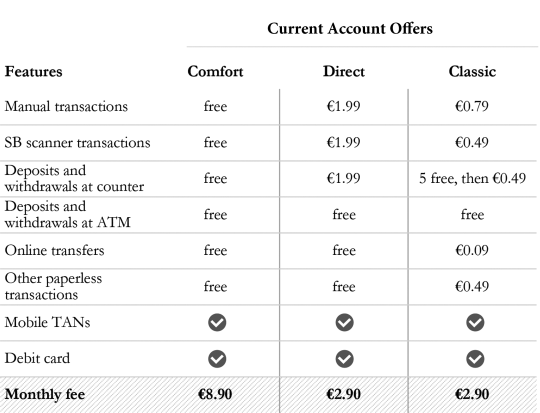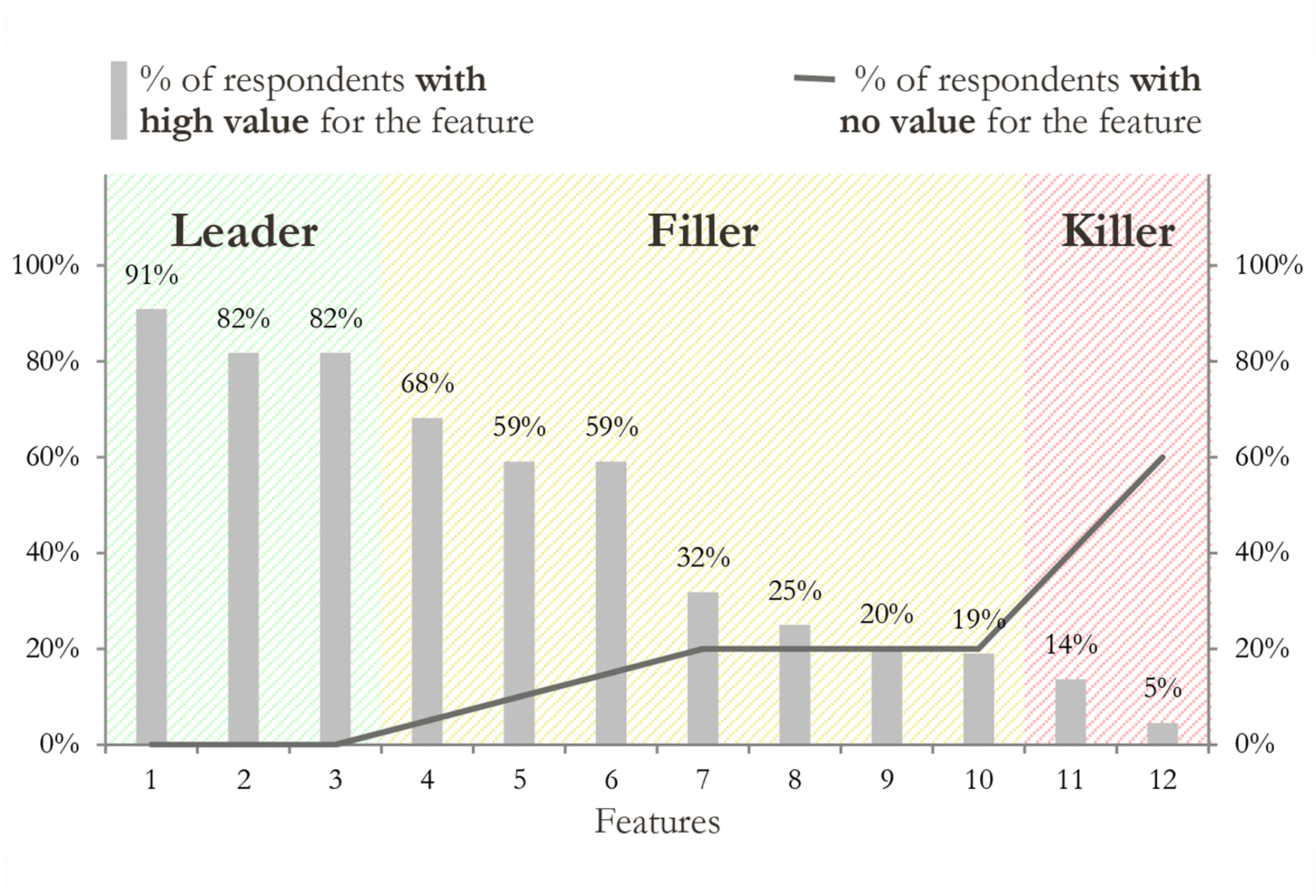Chapter 6
When Designing Products, Configuration and Bundling is More Science Than Art
So you've segmented your customer base along the lines we laid out in Chapter 5: on their needs, the value of your offering, and their willingness to pay (WTP) for that value. Now you're ready to get down and dirty into the design of what you'll offer each customer segment—exactly what features and functions to deliver. There are two core design decisions you will need to make here. One is product configuration, and the other is bundling. This chapter will examine and illustrate these important design constructs.
But first, a clarification: Our definition of product configuration refers to the decision of which features and functionalities will be included in a product. In some industries, like software and tech, product configuration is also referred to by the term packaging. By bundling, we mean combining a product or service with other products and services.
Successful innovators get the product configuration and bundling decisions right from the start.
Product Configuration Done Right
Doing product configuration right means you design a product with the right features for a segment—that is, just the features customers are willing to pay for. This is a core tenet of designing new products that will succeed in the marketplace. Too many features lead to feature shock products, especially if your customers are not wild about those features. If they are wild about them and you didn't realize it, you design a minivation. Products with features that customers won't pay for wind up undead.
Let's illustrate how product configuration works when it's done correctly. Do you remember the paper manufacturer we discussed in the last chapter? The company had identified four distinct customer segments, which it referred to as “want price only,” “want product only,” “want it now,” and “want the best.” The firm's next task was deciding how to design offerings that best addressed each segment. The firm gave each segment the specific features it needed most—again, as determined by that segment's needs, value, and WTP. This is captured in Figure 6.1.

Figure 6.1 A Segment-Based Product Offering in a Business-to-Business Market
The Core offering became the firm's basic product, which included the core product at a very affordable price. This offering had the standard level for technology, application support, and logistics services, and no extra features. In contrast, the Product Plus and Logistics Plus offerings had additional features—according to each segment's needs, value, and WTP. For instance, the Logistics Plus offering guaranteed next-day delivery of stock products and seven-day delivery of customized products. The offering also provided priority delivery in the event of inventory or capacity issues. The Best offering combined the features of the Product Plus and Logistics Plus offerings.
In designing each offering, the company was guided by the elements customers were willing to pay for. The firm integrated product and service features into the three more expensive offerings (as compared to the “want price only” offering) because those customers indicated they would pay extra for them. The result was the firm priced its Best offering at a significant premium compared to its base offering.
By having their feature sets tailored to each segment's needs, value, and WTP, each offering finally had a distinct value proposition. The design of these products also minimized the chances they would cannibalize one another, since customers clearly saw what they gave up at the lower price points. The way we like to put it is that the company established clear “fences” between its products. Customers only get a low price if they go without extra product or logistics services; the company can offer a low price on this product because value and costs are lower.
What we've just described may sound simple to accomplish. On the contrary, it typically is anything but. Leaving out features from a new product is extremely difficult for nearly every company in the product configuration phase of product development. It is especially hard for firms that compete on the basis of quality and like to stuff value-adding features into their new products. However, if they succumb to this temptation, they greatly risk cannibalizing the products they designed for each segment. Had the paper company's product developers felt the Core offering was far too basic and beefed it up with service and logistics features but kept the price the same, that product would have taken away customers who would have chosen the other three higher-priced offerings.
To maximize the monetization potential of new products, companies should curb their instincts to please customers by giving away value-added functionality—unless those customers will pay for it. These firms must get comfortable with the idea of giving their low-price segment only basic quality and service levels, rather than giving them everything. In other words, product configuration requires the guts to take away features.
Both product and service companies alike grapple with this problem of creating distinct offerings for each segment. Consider the experience of a regional European retail bank. Its executives asked us to look at the offering lineup for personal banking customers. Over time, the bank had added one new offering after the other. When we came in, the bank had 30 different account offerings. But what looked good on paper did not work at all in reality. The large number of choices made it harder for the sales force to sell them. Neither customers nor the bank's salespeople knew which offering was the best fit for a given customer. Thirty offerings was far too many.
We then interviewed a number of the bank's customers. What they wanted, and were willing to pay for, could be boiled down into three customer segments: Comfort (peace of mind was, by far, this segment's most important need, and they were willing to pay a high price for it); Direct (who preferred to do business online and rarely used the bank's offline services such as visiting the branches); and Classic (who used the branches frequently and did not trust or like its online services). With the bank team we developed three new offerings, each of which addressed those segments. (See Figure 6.2.)

Figure 6.2 A Retail Bank's Product Configuration Decision
The Comfort product came with all features and the highest price per month. The Direct and Classic products were offered at lower prices, but they lacked online or offline features.
So what happened after the bank shrank its thirty products to three? You might think sales plummeted because customers had far fewer choices. On the contrary, sales skyrocketed. Why? The bank had finally made each product distinct; its sales staff could articulate each product's value; and customers could easily determine which one best fit their needs. Total annual profit increased by 30 percent in the institution's personal banking services unit.
Bundling Done Right
Bundling helps you determine whether your products and/or services should be sold together or separately.
When done right, it can increase total profit because customers end up buying more than they would have if you hadn't bundled. Take an example many are familiar with: McDonald's and its Value Meals. With the Value Meal, McDonald's is trying to convince customers who might have skipped the soda or fries to go all in on the bundle. It's a win-win. The customer gets soda and fries for an appetizing bundle price; for its part, McDonald's realizes more revenue and profit.
You and your customers win when a good bundling decision is made. It not only boosts your revenue, it increases your customers' satisfaction because you've made the purchasing decision easier. They didn't have to choose between A or B; they got both, and generally for less than they would have paid separately for A and B.
Let's take a look at the benefits of bundling using a fun example—pizza and breadsticks—and an actual case study on Microsoft.
Now let's examine an actual example in practice to illustrate the benefits of bundling: Microsoft's iconic Office software.
Microsoft Office: A Bundling Blockbuster
Microsoft is a compelling example of a company that soared thanks to bundling. When it released its Office suite of software in the 1990s, its customer base was used to paying for word processing, e-mail, spreadsheet, and presentation software applications separately. Microsoft pitched a discounted price for the bundle (as opposed to individual application prices), and it touted how convenient it was to have all the applications in the suite have a similar look and feel. The bundle helped the company cement customer loyalty and grow market share in the face of pressure from plucky, perfectly competent competitors that focused only on parts of the solution (such as Lotus 1-2-3 for spreadsheets and WordPerfect for word processing).
Over time, Microsoft developed different versions of its Office suite that varied in functionality. That let different customer segments—business, home, and education customers—find options that suited their different needs. By 2013, the Office business division was Microsoft's biggest, accounting for about a third of the company's total revenue and more than 40 percent of operating profit.1
That's the benefit of bundling.
Two Key Principles of Product Configuration and Bundling
When you configure and bundle your new product, you may get overwhelmed with deciding which features to include in each segment offer. In a different way, it is easy for customers to become overwhelmed trying to decide which offer is right for them. Designing your product with leader, filler, and killer features in mind will help you with that first challenge. Creating good, better, and best options will address the second.
Principle #1: Leaders, Fillers, and Killers
You should approach your product configuration decision strategically—that is, through monetization techniques—to avoid leaving money on the table. To determine what features you should bake into which product configuration, you should start by separating the must-have features from the nice-to-haves. On their own, nice-to-haves won't convince customers to buy a product.
It's equally important to think about which features might turn off customers. Critical features—what we call leaders—are what drive customers to buy a product. Customers have high WTP for such leader features. Fillers are features of moderate importance or nice-to-haves. In contrast, killers are features that will blow the deal if the customer is forced to pay for them.
The leader/filler/killer classification is the most important aspect of configuring your new product. We described methods for doing this in Figure 4.3 in Chapter 4. You can see the kinds of output that come from such classifications in Figure 6.5. Here, Feature 1 is a leader since the majority of customers find value in it. In contrast, Feature 11 is a killer because a significant portion of people see no value in it, and only a few find it valuable. A killer feature should be eliminated from the offering, but it could be sold à la carte to the few who want it.

Figure 6.5 How Customers Viewed a Product's Features as Leaders/Fillers/Killers
Here's an easy way to identify killer features: Look for those that are valued by less than 20 percent of your customers and are not valued at all by more than 20 percent.
Sometimes, a product's features may fall into one category for a certain customer segment and another category for a different group. For example, for drivers in the frigid north, heated car seats are a leader. But in very warm or tropical climates, they are a filler (or even a killer if they add to the price of the car).
Customer segmentation is your tool for identifying these distinctions—that is, which features each segment considers to be leaders, fillers, and killers.
Principle #2: Creating Good, Better, and Best Options
The classic approach to product configuration and bundling is to create a three-tier model, sometimes referred to as good, better, best or G/B/B. Typically, the good version has the most important core features, and the best has all the bells and whistles (the all-in product/bundle). You have probably come across this concept many times in everyday life: bronze, silver, and gold offerings. For example, the pro, business, and enterprise products offered by online file sharing website Dropbox are a G/B/B offering. Ideally, no more than a quarter of your customers should opt for the good option, while 70 percent should opt for the better or the best.
Why does a well-crafted G/B/B configuration/bundle work? Because you can steer customers to a choice based on whether they are price conscious (good), quality conscious (best), or somewhere in between (better). The core philosophy behind a G/B/B is that a significant portion of people avoid extremes when they are presented a choice; they choose the compromise option. Playing on this psychology, G/B/B configuration/bundling maximizes sales.
Think of a sales negotiation. If the salesperson only has one product to sell, the discussion with customers is black-and-white—a “take it or leave it” proposition. But with a G/B/B offering, the salesperson can switch between the good offer (if the customer focuses on price), the best offer (if the customer talks quality), or the better offer (if the customer wants both price and quality). In most cases, the better offer greatly increases the probability that a salesperson closes a deal. It also maximizes the new product's monetizing potential.
But a word of caution: While three is the classic number of product configurations/offerings, you could still use a G/B/B structure with a greater number of configurations—as long as you provide more value as you move from the good to best product configuration. Ideally, you should design each product to appeal to a substantial segment you have identified. In addition, the number of product configurations you decide on should be aligned with the number of distinct customer segments you have.
Insights, Tips, and Tricks
Before you rush headlong into figuring out your product configurations and bundles, here are 10 tips to guide you:
- Align with segments. If you've followed the principles in this book, your offers should align with your customer segments. That is, they should reflect each segment's needs, value, and WTP. If you don't design your offers with segmentation in mind, customers are unlikely to buy them.
- Don't make it too big. Once you go beyond nine benefits or four products, your product configurations and bundles run the risk of exceeding psychological thresholds. Your product will start making customers' heads spin, and you will be heading toward producing a feature shock product!
- Make sure you and your customers both benefit. The right product configuration and bundling provide benefits to both you and your customers (not just one or the other). The benefits to you should include more revenue (through increased acquisition and cross-selling), decreased price transparency, and higher customer loyalty (or increased switching costs). The benefits for customers include the added convenience of buying from a single provider, discounts, and an integrated experience from the bundle.
- Don't give too much away in your entry-level product. In many industries, companies focus first on acquiring customers and then upselling. This strategy is often called land and expand. To increase customer acquisition, many companies pack too much into their entry-level product. But then they struggle to upsell customers since the functionality difference in the better or best product is marginal at best. Consequently, these companies land but don't expand. If more than 50 percent of your customers have bought your entry-level product, you most likely have this problem. If so, you should seriously consider removing features from your entry-level product. The ideal distribution of customers for a G/B/B product configuration strategy is 30 percent in good and 70 percent in better and best, with best being at least 10 percent.
- Hard bundling will not always work. The standard approach is called a mixed bundle: The consumer has a choice of buying the bundle or buying the components in the bundle à la carte. But some companies are more rigid. They employ hard bundling, which means they do not give the customer the option to buy components of the bundle piecemeal. Some vacations, for example, are priced as all-inclusive—transport, hotel, meals, drinks, and activities; you cannot just book the hotel by itself. Hard bundling works when you have market power and are the dominant player. In almost all other cases, you should go with a mixed bundling approach.
- Individual prices need to be higher with mixed bundling. If you create a mixed bundle and individual products are also sold separately, the à la carte price within the mixed bundle must be higher than the stand-alone optimal price in the unbundled situation. For example, if you hadn't offered a bundle in the pizza and breadsticks example (see Figure 6.3), you would have priced the individual product at $8. But if you offered a mixed bundle, you would price it higher—in this case, at $9.
- Don't forget bundle price communication. Bundling offers you the unique opportunity to showcase your prices creatively and strategically. Suppose a customer really likes Product A and considers Product B a nice-to-have. Assume both were priced at $100 and you are prepared to give a 20 percent discount on the bundle. Saying “You get 20 percent discount on total price of the bundle” is totally different than saying “You get a 40 percent discount on Product A when you purchase it with Product B.” Even though mathematically it amounts to the same price, customers are likely to find the latter option more appealing.
- Bundle with integration value so that 1 + 1 = 3. Bundling is not always about discounting. In certain industries, such as software, you can sometimes charge a premium for bundling products together because customers are willing to pay for integrated product experiences (such as common user interface and seamless interoperability between products). In these situations, if you offer a discount on the bundle, you will hurt your bottom line two times over!
- Don't bundle for the sake of bundling. You could lose a lot of money if you do. If customers would have purchased your individual products anyway, you are giving an unnecessary discount by bundling them.
- Exploit inverse correlations. This is an advanced tip. If you find two customer segments with inverse preferences, you can bundle products together to serve both segments. For example, if one segment finds Product A a must-have and Product B a nice-to-have, and another segment finds Product B a must-have and Product A a nice-to-have, your best strategy may be to bundle A and B and sell one bundle to both segments.
